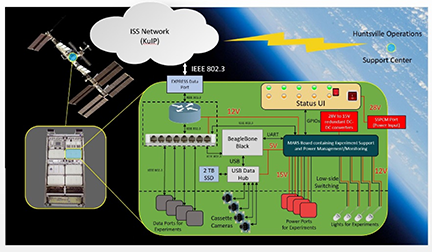
Over the course of four months, Department of Engineering Technology and Industrial Distribution students Dakotah Karrer and Vincent Rodriguez worked with faculty member Dr. Joseph Morgan and Matt Leonard, president and CEO of Texas Space Technology Applications and Research (T STAR) on a special tube-like experiment station known as Strata-1.
 The integrated hardware and software system within Strata-1 helps identify properties of regolith, the material found on the surface of airless planetary bodies. Interacting with regolith becomes a challenge in a low-gravity environment. As robotic and crewed missions visit small bodies such as asteroids, it will be important to understand how to anchor to these surfaces.
The integrated hardware and software system within Strata-1 helps identify properties of regolith, the material found on the surface of airless planetary bodies. Interacting with regolith becomes a challenge in a low-gravity environment. As robotic and crewed missions visit small bodies such as asteroids, it will be important to understand how to anchor to these surfaces.
In the spring of 2016, Strata-1 was launched to study the evolution of asteroid regolith through long duration exposure of simulant materials to the microgravity environment on the International Space Station.
Despite its short development and launch window, the Strata-1 experiment was a success. The NASA scientists who originally conducted the experiment were granted funding for a new Class 1E research facility named Hermes, which will reside on the ISS for five-plus years to host, monitor and control groups of up to four experiments.
When again contracted by NASA to develop Hermes, T STAR turned to a capstone team within the engineering technology and industrial distribution department to design and deliver the electronics package for the system.
The capstone team Microgravity Automated Research Systems (MARS), consisting of five students from the Electronic Systems Engineering Technology (ESET) program in the department, have been working on the HERMES facility electronic equipment over the past academic year.
Recently, Karrer and Rodriguez (now engineers with Texas Instruments) came back to campus to meet with Dr. Morgan Leonard, original Strata-1 experiment scientists Dr. Kristen John and Lee Graham, and the MARS capstone team to discuss the history and future of the project.
MARS and T STAR are continuing the work of Karrer and Rodriguez via the Hermes facility, which will be capable of hosting up to four experiments at a time that can be changed out multiple times during the facility’s lifetime.
“Hermes is an experimental microgravity facility that enables science experiments, microgravity exposure testing, testing of engineering components, concept trials and any payloads that fit within the Hermes design and operations constraints. It is open to any investigation that benefits from microgravity exposure,” said Dr. John, principal investigator for Hermes.
Given the durability of Hermes, a multitude of experiments can be conducted over its five-year mission on the ISS. The four chambers inside the facility can be interchanged as needed, giving NASA scientists the freedom and flexibility to conduct their research accordingly with minimum deployment costs and varying project timelines.
The facility includes lighting, image recording capabilities and a robust electrical interface being developed by MARS which will give scientists complete access to power, computation and control. MARS is also developing software that will allow scientists to achieve desired lighting, camera use and electrical components that are uplinked from the ground to Hermes.
NASA has stated that possible experiments could include “asteroid regolith investigations, life cycle tests of engineering components, and penetrometer and anchoring demonstrations. Any investigation that can benefit from exposure to microgravity can be incorporated into Hermes as long as it meets the specified structural, electrical and safety standards.”
 At this year’s Engineering Project Showcase, MARS received the first place award for all projects in the department and was presented the Emerson Award for their efforts.
At this year’s Engineering Project Showcase, MARS received the first place award for all projects in the department and was presented the Emerson Award for their efforts.
The partnership between ESET students, T STAR and NASA continues to grow with exciting opportunities such as Strata-1 and the Hermes facility. Other projects being developed by the partnership include TSAT and the DSTR robot.
During the presentation of the Strata-1 Flight Unit to department head Dr. Reza Langari, Leonard summed up the Strata-1/Hermes meeting by stating, “The innovation and rapid prototyping capabilities available within the department’s Product Innovation Cellar and Mobile Integrated Solutions Laboratory have allowed T STAR to successfully design and develop solutions for NASA scientists in a timely and cost-effective manner while engaging students in a real-world project.”